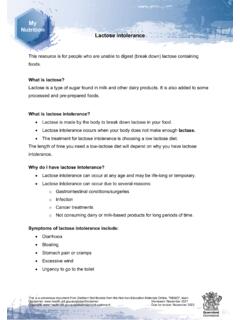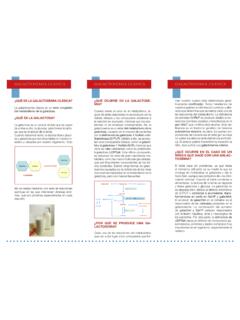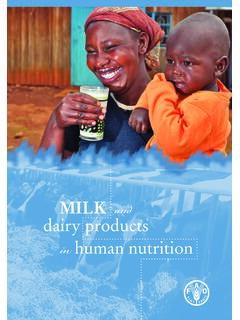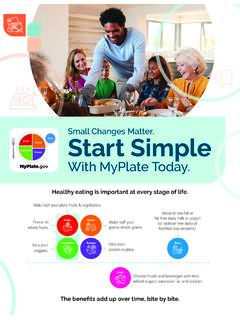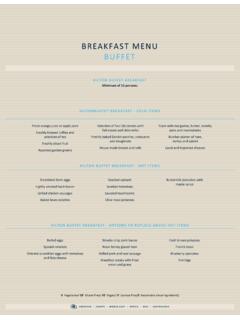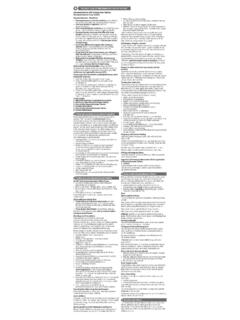Transcription of Infant Formula - AAFP Home
1 April 1, 2009 Volume 79, Number 7 American Family Physician 565 Infant FormulaNINA R. O CONNOR, MD, Chestnut Hill Family Practice Residency, Philadelphia, Pennslyvanialthough the American Academy of Family Physicians and the Ameri-can Academy of Pediatrics (AAP) promote breastfeeding as optimal Infant nutrition, many parents still choose Infant Formula as an acceptable ,2 The wide variety of available formulas can be confusing and overwhelming for parents and physicians, and Formula companies target both audiences with advertising campaigns. Family physicians can advise parents about Infant Formula choices based on available evidence. Additionally, family physicians should identify the minority of infants who would benefit from a specialized formulas are classified based on three parameters: caloric density, carbohydrate source, and protein composition.
2 Commer-cially available Infant formulas are presented by these parameters in Table FormulasMost infants need a basic Formula for term infants. These formulas are modeled after breast milk and contain 20 kcal per ounce. Their carbohydrate source is lactose , and they contain cow s-milk protein. There is no evidence to recommend one brand over another; all formulas are nutritionally infants should receive iron-fortified Formula to prevent iron deficiency ,4 Low-iron formulas are commercially avail-able, and some parents choose these formu-las with the belief that iron causes stomach upset. Family physicians should strongly counsel parents to not use these products. Recently, formulas with long-chain poly-unsaturated fatty acids have been heav-ily marketed to promote eye and brain development.
3 Arachidonic acid (AA) and docosahexaenoic acid (DHA) are the most common additives. These fatty acids are found in breast milk, but not conventional Formula , and are thought to be important in the development of membrane constituents in the central nervous system. Clinical trials of the effects of AA and DHA on cognitive, social, and motor development have been inconsistent. Although no harm has been demonstrated, most well-conducted ran-domized trials show no benefit. Thus, recent Cochrane reviews conclude that supplemen-tation of Formula with DHA and AA cannot Although the American Academy of Pediatrics and the American Academy of Family Physicians recommend breast milk for optimal Infant nutrition, many parents still choose Formula as an acceptable alternative.
4 The wide variety of available formulas is confusing to parents and physicians, but formulas can be classified according to three basic cri-teria: caloric density, carbohydrate source, and protein composition. Most infants require a term Formula with iron. There is insufficient evidence to recommend supplementation with docosahexaenoic acid or arachidonic acid. Soy formulas are indicated for congenital lac-tase deficiency and galactosemia, but are not recommended for colic because of insufficient evidence of benefit. Hypoallergenic formulas with extensively hydrolyzed protein are effective for the treatment of milk protein allergy and the prevention of atopic disease in high-risk infants. Antireflux formulas decrease emesis and regurgitation, but have not been shown to affect growth or development.
5 Most infants with reflux require no treatment. Family physicians can use these guidelines to counsel parents about Infant Formula , countering con-sumer advertising that is not evidence-based. (Am Fam Physician. 2009;79(7):565-570. Copyright 2009 American Academy of Family Physicians.) Patient informa-tion: A handout on baby Formula , written by the author of this article, is available at This clinical content con-forms to AAFP criteria for evidence-based continuing medical education (EB CME).ILLUSTRATION BY BeRT S. OppeNheIm ANd ChRIS SCALICIAD ownloaded from the American Family Physician Web site at Copyright 2009 American Academy of Family Physicians. For the private, noncommercial use of one individual user of the Web site.
6 All other rights reserved. Contact for copyright questions and/or permission American Family Physician Volume 79, Number 7 April 1, 2009 SORT: KEY RECOMMENDATIONS FOR PRACTICE Clinical recommendationEvidence rating ReferencesThere is insufficient evidence to recommend supplementation of Infant Formula with docosahexaenoic acid or arachidonic , 6 Preterm and enriched formulas may improve short-term growth parameters in premature infants, but have not been shown to improve long-term growth or Formula is effective for the treatment of milk protein allergy and the prevention of atopic , 16, 25 Antireflux formulas reduce daily emesis and regurgitation in infants, but have not been shown to improve growth or , 26 Parental counseling is more effective than changing Formula in the treatment of Infant = consistent, good-quality patient-oriented evidence.
7 B = inconsistent or limited-quality patient-oriented evidence; C = consensus, disease-oriented evidence, usual practice, expert opinion, or case series. For information about the SORT evidence rating system, go to 1. Comparison of Breast Milk and Available Infant Formulas ClassBrand namesCalories (kcal per oz)Carbohydrate sourceProtein source IndicationsCost per ounce*Powdered Formula Ready-to-feedBreast milk 20 LactoseHuman milk Preferred for all infants Term Formula Carnation Good Start; Enfamil with Iron; Similac with Iron20 LactoseCow s milk Appropriate for most infants$ $ Formula with DHA and AAEnfamil Lipil; Good Start DHA Similac Advance 20 LactoseCow s milk Marketed to promote eye and brain formulaEnfamil 24 Premature; Preemie SMA 24; Similac 24 Special Care24 LactoseCow s milk Less than 34 weeks gestationWeight less than 1,800 g (3 lb, 15 oz) formulaEnfacare.
8 Similac Neosure22 LactoseCow s milk 34 to 36 weeks gestationWeight 1,800 g (3 lb, 15 oz) or formulaEnfamil Prosobee; Good Start Soy; Similac Isomil 20 Corn-basedSoy Congenital lactase deficiency, galactosemia formulaEnfamil Lactofree; Similac Sensitive 20 Corn-basedCow s milk Congenital lactase deficiency, primary lactase deficiency, galactosemia, gastroenteritis in at-risk formulaSimilac Alimentum; Enfamil Nutramigen; Enfamil Pregestimil20 Corn or sucroseExtensively hydrolyzed Milk protein formulaElecare; Neocate; Nutramigen AA20 Corn or sucroseAmino acids Milk protein Antireflux formulaEnfamil AR; Similac Sensitive RS20 lactose , thickened with rice starchCow s milk Gastroesophageal formulaEnfamil Next Step; Good Start 2; Similac Go and Grow 20 LactoseMilk Nine to 24 months of = arachidonic acid; DHA = docosahexaenoic acid.
9 * Calculated from average retail price. Most information comes from After adding FormulaApril 1, 2009 Volume 79, Number 7 American Family Physician 567be recommended based on current ,6 Addition-ally, these formulas cost more than formulas without the above and Enriched FormulasPreterm infants have higher protein and calorie require-ments. In addition, they need more calcium, magne-sium, and phosphorus (minerals transferred in utero during the third trimester). These special requirements led to the development of enriched and preterm formu-las designed to facilitate catch-up growth. Preterm formulas contain 24 kcal per ounce, whereas enriched formulas contain 22 kcal per ounce. Enriched formulas are available in stores as liquid or powder.
10 Preterm for-mulas must be ordered in ready-to-feed bottles and are more is currently the standard of care to prescribe these formulas for preterm infants. Cut-offs for weight and gestational age are based on expert opinion, with varia-tion between institutions. Infants are usually transi-tioned from 24 to 22 kcal per ounce when they achieve a weight of 1,800 g (3 lb, 15 oz) or 34 weeks gestational Hospital discharge is rare before 34 weeks, so infants presenting for outpatient care are typically on 22-kcal Formula . There are no studies to guide timing for the discontinuation of enriched Formula . Although preterm and enriched formulas may improve short-term growth parameters, they do not appear to affect longer-term growth or development at 18 months of Term FormulasMost infants tolerate standard Formula , but family physicians should screen for the minority of infants with feeding intolerance (Table 2).










